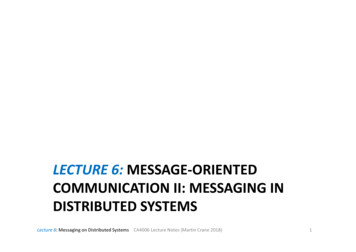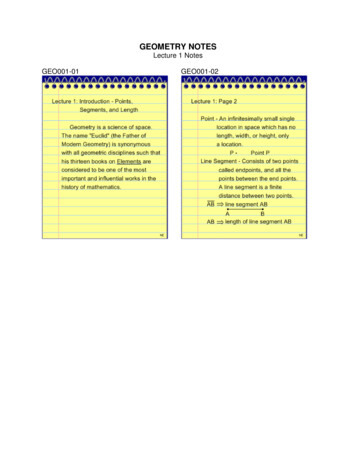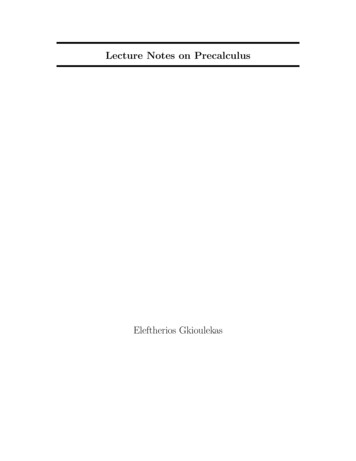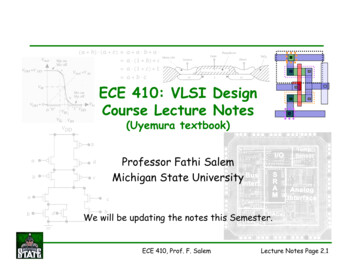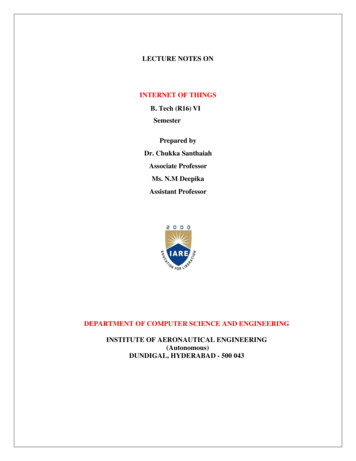
Transcription
LECTURE NOTES ONINTERNET OF THINGSB. Tech (R16) VISemesterPrepared byDr. Chukka SanthaiahAssociate ProfessorMs. N.M DeepikaAssistant ProfessorDEPARTMENT OF COMPUTER SCIENCE AND ENGINEERINGINSTITUTE OF AERONAUTICAL ENGINEERING(Autonomous)DUNDIGAL, HYDERABAD - 500 043
INSTITUTE OF AERONAUTICAL ENGINEERING(Autonomous)Dundigal, Hyderabad -500 043COMPUTER SICENCE AND ENGNEERINGCOURSE DESCRIPTORCourse Title INTERNET OF THINGS (IoT)Course Code ACS510Programme B. TechVICSEITSemesterCourse Type ElectiveIARE - tLaboratoCreditCoursesrysStructure33ChiefMs. N.M Deepika, Assistant Professor, CSECoordinatorDr. Chukka Santhaiah, Associate Professor, CSECourseMs. P. Navya, Assistant Professor, ITFacultyCOURSE OBJECTIVES (COs):The course should enable the students to:IUnderstand the architecture of Internet of Things and connected world.IIExplore on use of various hardware and sensing technologies to build IoTapplications.IIIIllustrate the real time IoT applications to make smart world.Understand the available cloud services and communication API„s for developingIsmartVcities.COURSE LEARNING OUTCOMES (CLOs):CLOCodeCLO’sACS510.01CLO 1ACS510.02CLO 2ACS510.03CLO 3At the end of the course, thestudent will have theability to:Understand and intuition of thewhole process line of extractingknowledge from data about theInternet of Things.Deep insight inone of thespecializationswithin the networkSolid knowledge in a broad range ofmethods based on design andimplementation of IoT in 32
performance, analysis.ACS510.04CLO 4ACS510.05CLO 5ACS510.06CLO 6ACS510.07CLO 7ACS510.08CLO 8ACS510.09ACS510.10CLO 9CLO 10ACS510.11CLO 11ACS510.12CLO 12ACS510.13CLO 13ACS510.14CLO 14ACS510.15CLO 15Experience in deriving theoreticalpropertiesof methods involved in IoT.Design andimplementation/modification ofmethods involved in IoT.Describe what IoT is and the skill setsneededto be a network analysis.Use IoT design to carry out basicstatisticalmodeling and analysis.Motivate and explain trade-offs in IoTtool technique design and analysis ofapplicationsWith IoT.Understand significance of models inIoT.Describe the Transport layerprotocols and how its uses in IoTApply basic IoT algorithms forpredictivenetwork performance.Understand basic terms what securityissues.Identify key distribution methods.Identify common approaches usedforFeature Generation of IoT.Create effective results by usingvarious techniques in IoTapplication.Analyze the importance of IoTapplicationsandworkeffectively as individual orteams on VariousIoT O31PO12PO1;PO22
SYLLABUSII Group: CSE / ITCourse CodeACS510CategoryElectiveContact Classes: 45Tutorial Classes: NilHours / WeekCreditsLPTC33Practical Classes: NilMaximum MarksCIASEE Total3070100Total Classes: 45OBJECTIVES:The course should enable the students to:I. Understand the architecture of Internet of Things and connected world.II. Explore on use of various hardware, communication and sensing technologies to build IoTapplications.III. Illustrate the real time IoT applications to make smart world.IV. Understand challenges and future trends in IoT.COURSE OUTCOMES (COs):The Students should enable to:CO 1 Understand the architecture of Internet of Things and connected world.CO 2 Explore the use of various hardware and sensing technologies to build IoT applications.CO 3 Illustrate the real time IoT applications to make smart world.CO 4 Understand the available cloud services and communication API's for developing smart cities.COURSE LEARNING OUTCOMES(CLOs):Students, who complete the course, will have demonstrated the ability to do the following:1. Understand and intuition of the whole process line of extracting knowledge from data about theInternet of Things.2. Deep insight in one of the specializations within the network, depending on the study and the choiceof the concepts of IoT.3. Solid knowledge in a broad range of methods based on design and implementation of IoT innetwork performance, analysis and problem solving with design of networks.4. Experience in deriving theoretical properties of methods involved in IoT.5. Design and implementation/modification of methods involved in IoT.6. Describe what IoT is and the skill sets needed to be a network analysis.7. Use IoT design to carry out basic statistical modeling and analysis.8. Motivate and explain trade-offs in IoT tool technique design and analysis of applications with IoT.9. Understand significance of models in IoT.10. Describe the Transport layer protocols and how its uses in IoT.11. Apply basic IoT algorithms for predictive network performance.12. Understand basic terms what security issues. Identify key distribution methods.13. Identify common approaches used for Feature Generation of IoT.14. Create effective results of IoT future approaches.15. Work effectively in teams on IoT projects.UNIT-IINTRODUCTION TO INTERNET OF THINGS (IoT)Classes: 08Definition and characteristics of IoT, physical design of IoT, logical design of IoT, IoT enablingtechnologies, IoT levels and deployment, domain specific IoTs.\
UNIT-II IoT AND M2MClasses: 10Introduction, M2M, difference between IoT and M2M, software defined networking (SDN) andnetwork function virtualization (NFV) for IoT, basics of IoT system management with NETCONFYANG.UNIT-III IoT PLATFORMS DESIGN METHODOLOGYClasses: 10IoT Architecture: State of the art introduction, state of the art; Architecture reference model: Introduction,reference model and architecture, IoT reference model.Logical design using Python: Installing Python, Python data types and data structures, control flow,functions, modules, packages, file handling.UNIT-IV IoT PHYSICAL DEVICES AND ENDPOINTSClasses: 08Introduction to Raspberry Pi interfaces (Serial, SPI, I2C), programming Raspberry PI with Python,other IoT devices.UNIT-V IoT PHYSICAL SERVERS AND CLOUD OFFERINGSClasses: 09Introduction to cloud storage models and communication APIs, WAMP – AutoBahn for IoT, Xivelycloud for IoT, case studies illustrating IoT design – home automation, smart cities, smart environment.Text Books:1. Arshdeep Bahga, Vijay Madisetti, ―Internet of Things: A Hands-on-Approach‖, VPT, 1stEdition, 2014.2. Matt Richardson, Shawn Wallace, ―Getting Started with Raspberry Pi‖, O‘Reilly (SPD), 3rd Edition,Reference2014. Books:1. Adrian McEwen, Hakim Cassimally, ―Designing the Internet of Things‖, John Wiley and Sons 2014.2. Francis daCosta, “Rethinking the Internet of Things: A Scalable Approach to Connecting Everything‖,A press Publications, 1st Edition2013.Web m.E-Text Books:1. https://mitpress.mit.edu/books/internet-things2. http://www.apress.com
UNIT-IINTRODUCTION OF IOTIoT comprises things that have unique identities and are connected to internet. By 2020 there willbe a total of 50 billion devices /things connected to internet. IoT is not limited to just connectingthings to the internet but also allow things to communicate and exchange data.Definition:A dynamic global n/w infrastructure with self configuring capabilities based on standard andinteroperable communication protocols where physical and virtual ―things‖ have identities,physical attributes and virtual personalities and use intelligent interfaces, and are seamlesslyintegrated into information n/w, often communicate data associated with users and theirenvironments.Characteristics:1) Dynamic & Self Adapting: IoT devices and systems may have the capability todynamically adapt with the changing contexts and take actions based on their operatingconditions, user‗s context or sensed environment.Eg: the surveillance system is adapting itself based on context and changing conditions.2) Self Configuring: allowing a large number of devices to work together to provide certainfunctionality.3) Inter Operable Communication Protocols: support a number of interoperablecommunication protocols and can communicate with other devices and also withinfrastructure.4) Unique Identity: Each IoT device has a unique identity and a unique identifier (IPaddress).5) Integrated into Information Network: that allow them to communicate and exchangedata with other devices and systems.Applications of etailLogisticsAgricultureIndustryHealth & Life Style
Physical Design of IoT1) Things in IoT:
The things in IoT refers to IoT devices which have unique identities and perform remote sensing,actuating and monitoring capabilities. IoT devices can exchange data with other connecteddevices applications. It collects data from other devices and process data either locally orremotely.An IoT device may consist of several interfaces for communication to other devices both wiredand wireless. These includes (i) I/O interfaces for sensors, (ii) Interfaces for internet connectivity(iii) memory and storage interfaces and (iv) audio/video interfaces.2) IoT Protocols:a) Link Layer : Protocols determine how data is physically sent over the network‗sphysical layer or medium. Local network connect to which host is attached. Hosts on thesame link exchange data packets over the link layer using link layer protocols. Link layerdetermines how packets are coded and signaled by the h/w device over the medium towhich the host is attached.
Protocols: 802.3-Ethernet: IEEE802.3 is collection of wired Ethernet standards for the link layer.Eg: 802.3 uses co-axial cable; 802.3i uses copper twisted pair connection; 802.3j usesfiber optic connection; 802.3ae uses Ethernet over fiber. 802.11-WiFi: IEEE802.11 is a collection of wireless LAN(WLAN) communicationstandards including extensive description of link layer. Eg: 802.11a operates in 5GHzband, 802.11b and 802.11g operates in 2.4GHz band, 802.11n operates in 2.4/5GHzband, 802.11ac operates in 5GHz band, 802.11ad operates in 60Ghzband. 802.16 - WiMax: IEEE802.16 is a collection of wireless broadband standards includingexclusive description of link layer. WiMax provide data rates from 1.5 Mb/s to 1Gb/s. 802.15.4-LR-WPAN: IEEE802.15.4 is a collection of standards for low rate wirelesspersonal area network(LR-WPAN). Basis for high level communication protocols such asZigBee. Provides data rate from 40kb/s to250kb/s. 2G/3G/4G-Mobile Communication: Data rates from 9.6kb/s(2G) to up to100Mb/s(4G).B) Network/Internet Layer: Responsible for sending IP datagrams from source n/w todestination n/w. Performs the host addressing and packet routing. Datagrams containssource and destination address.Protocols: IPv4: Internet Protocol version4 is used to identify the devices on a n/w using ahierarchical addressing scheme. 32 bit address. Allows total of 2**32addresses. IPv6: Internet Protocol version6 uses 128 bit address scheme and allows 2**128addresses.
rk)operates in2.4 GHz frequency range and data transfer 250 kb/s.C) Transport Layer: Provides end-to-end message transfer capability independent of theunderlying n/w. Set up on connection with ACK as in TCP and without ACK as in UDP.Provides functions such as error control, segmentation, flow control and congestion control.Protocols: TCP: Transmission Control Protocol used by web browsers(along with HTTP andHTTPS), email(along with SMTP, FTP). Connection oriented and stateless protocol. IPProtocol deals with sending packets, TCP ensures reliable transmission of protocols inorder. Avoids n/w congestion and congestion collapse. UDP: User Datagram Protocol is connectionless protocol. Useful in time sensitiveapplications, very small data units to exchange. Transaction oriented and statelessprotocol. Does not provide guaranteed delivery.D) Application Layer: Defines how the applications interface with lower layer protocols tosend data over the n/w. Enables process-to-process communication using ports.Protocols: HTTP: Hyper Text Transfer Protocol that forms foundation of WWW. Follow requestresponse model Stateless protocol. CoAP: Constrained Application Protocol for machine-to-machine (M2M) applicationswith constrained devices, constrained environment and constrained n/w. Uses clientserver architecture. WebSocket: allows full duplex communication over a single socket connection. MQTT: Message Queue Telemetry Transport is light weight messaging protocol basedon publish-subscribe model. Uses client server architecture. Well suited for constrainedenvironment. XMPP: Extensible Message and Presence Protocol for real time communication andstreaming XML data between network entities. Support client-server and server-servercommunication. DDS: Data Distribution Service is data centric middleware standards for device-to-deviceor machine-to-machine communication. Uses publish-subscribe model. AMQP: Advanced Message Queuing Protocol is open application layer protocol forbusiness messaging. Supports both point-to-point and publish-subscribe model.LOGICAL DESIGN of IoTRefers to an abstract represent of entities and processes without going into the low levelspecifies of implementation.1) IoT Functional Blocks 2) IoT Communication Models 3) IoT Comm. APIs1) IoT Functional Blocks: Provide the system the capabilities for identification, sensing,actuation, communication and management.
Device: An IoT system comprises of devices that provide sensing, actuation, monitoringand control functions.Communication: handles the communication for IoTsystem.Services: for device monitoring, device control services, data publishing services andservices for device discovery.Management: Provides various functions to govern the IoT system.Security: Secures IoT system and priority functions such as authentication,authorization, message and context integrity and data security.Application: IoT application provide an interface that the users can use to control andmonitor various aspects of IoT system.2) IoT Communication Models:1) Request-Response 2) Publish-Subscibe 3)Push-Pull4) ExclusivePair1) Request-Response Model:
In which the client sends request to the server and the server replies to requests. Is astateless communication model and each request-response pair is independent of others.2) Publish-Subscibe Model:Involves publishers, brokers and consumers. Publishers are source of data. Publishers send datato the topics which are managed by the broker. Publishers are not aware of the consumers.Consumers subscribe to the topics which are managed by the broker. When the broker receivesdata for a topic from the publisher, it sends the data to all the subscribed consumers.3) Push-Pull Model: in which data producers push data to queues and consumers pull datafrom the queues. Producers do not need to aware of the consumers. Queues help indecoupling the message between the producers and consumers.
4) Exclusive Pair: is bi-directional, fully duplex communication model that uses apersistent connection between the client and server. Once connection is set up it remainsopen until the client send a request to close the connection. Is a stateful communicationmodel and server is aware of all the open connections.3) IoT Communication APIs:a) REST based communication APIs(Request-Response Based Model)b) WebSocket based Communication APIs(Exclusive PairBased Model)a) REST based communication APIs: Representational State Transfer(REST) is a set ofarchitectural principles by which we can design web services and web APIs that focus on asystem‗s resources and have resource states are addressed and transferred.The REST architectural constraints: Fig. shows communication between client server withREST APIs.
Client-Server: The principle behind client-server constraint is the separation of concerns.Separation allows client and server to be independently developed and updated.Stateless: Each request from client to server must contain all the info. Necessary to understandthe request, and cannot take advantage of any stored context on the server.Cache-able: Cache constraint requires that the data within a response to a request be implicitlyor explicitly labeled as cache-able or non-cacheable. If a response is cache-able, then a clientcache is given the right to reuse that response data for later, equivalent requests.Layered System: constraints the behavior of components such that each component cannot seebeyond the immediate layer with which they are interacting.User Interface: constraint requires that the method of communication between a client and aserver must be uniform.Code on Demand: Servers can provide executable code or scripts for clients to execute in theircontext. This constraint is the only one that is optional.Request-Response model used by REST:
RESTful web service is a collection of resources which are represented by URIs. RESTful webAPI has a base URI(e.g: http://example.com/api/tasks/). The clients and requests to these URIsusing the methods defined by the HTTP protocol(e.g: GET, PUT, POST or DELETE). ARESTful web service can support various internet media types.b) WebSocket Based Communication APIs: WebSocket APIs allow bi-directional, fullduplex communication between clients and servers. WebSocket APIs follow theexclusive pair communication model.IoT Enabling TechnologiesIoT is enabled by several technologies including Wireless Sensor Networks, CloudComputing, Big Data Analytics, Embedded Systems, Security Protocols and architectures,Communication Protocols, Web Services, Mobile internet and semantic search engines.1) Wireless Sensor Network(WSN): Comprises of distributed devices with sensors whichare used to monitor the environmental and physical conditions. Zig Bee is one of the mostpopular wireless technologies used byWSNs.WSNs used in IoT systems are described as follows: Weather Monitoring System: in which nodes collect temp, humidity and otherdata, which is aggregated and analyzed. Indoor air quality monitoring systems: to collect data on the indoor air quality andconcentration of various gases. Soil Moisture Monitoring Systems: to monitor soil moisture at variouslocations. Surveillance Systems: use WSNs for collecting surveillance data(motiondatadetection). Smart Grids : use WSNs for monitoring grids at variouspoints.
Structural Health Monitoring Systems: Use WSNs to monitor the health ofstructures(building, bridges) by collecting vibrations from sensor nodes deployedat various points in the structure.2) Cloud Computing: Services are offered to users in different forms. Infrastructure-as-a-service(IaaS):provides users the ability to provision computingand storage resources. These resources are provided to the users as a virtualmachine instances and virtual storage. Platform-as-a-Service(PaaS): provides users the ability to develop and deployapplication in cloud using the development tools, APIs, software libraries andservices provided by the cloud service provider. Software-as-a-Service(SaaS): provides the user a complete software application orthe user interface to the application itself.3) Big Data Analytics: Some examples of big data generated by IoT are Sensor data generated by IoT systems. Machine sensor data collected from sensors established in industrial and energysystems. Health and fitness data generated IoT devices. Data generated by IoT systems for location and tracking vehicles. Data generated by retail inventory monitoring systems.4) Communication Protocols: form the back-bone of IoT systems and enable networkconnectivity and coupling to applications. Allow devices to exchange data over network. Define the exchange formats, data encoding addressing schemes for device androuting of packets from source to destination. It includes sequence control, flow control and retransmission of lost packets.5) Embedded Systems: is a computer system that has computer hardware and softwareembedded to perform specific tasks. Embedded System range from low cost miniaturizeddevices such as digital watches to devices such as digital cameras, POS terminals,vending machines, appliances etc.,IoT Levels and Deployment Templates1) IoT Level1: System has a single node that performs sensing and/or actuation, stores data,performs analysis and host the application as shown in fig. Suitable for modeling lowcost and low complexity solutions where the data involved is not big and analysisrequirement are not computationally intensive. An e.g., of IoT Level1 is Homeautomation.
2) IoT Level2: has a single node that performs sensing and/or actuating and local analysisas shown in fig. Data is stored in cloud and application is usually cloud based. Level2 IoTsystems are suitable for solutions where data are involved is big, however, the primaryanalysis requirement is not computationally intensive and can be done locally itself. Ane,g., of Level2 IoT system for Smart Irrigation.3) IoT Level3: system has a single node. Data is stored and analyzed in the cloudapplication is cloud based as shown in fig. Level3 IoT systems are suitable for solutionswhere the data involved is big and analysis requirements are computationally intensive.An example of IoT level3 system for tracking package handling.
4) IoT Level4: System has multiple nodes that perform local analysis. Data is stored in thecloud and application is cloud based as shown in fig. Level4 contains local and cloudbased observer nodes which can subscribe to and receive information collected in thecloud from IoT devices. An example of a Level4 IoT system for Noise Monitoring.5) IoT Level5: System has multiple end nodes and one coordinator node as shown in fig.The end nodes that perform sensing and/or actuation. Coordinator node collects data nalyzedinthecloudand
application is cloud based. Level5 IoT systems are suitable for solution based on wirelesssensor network, in which data involved is big and analysis requirements arecomputationally intensive. An example of Level5 system for Forest Fire Detection.6) IoT Level6: System has multiple independent end nodes that perform sensing and/oractuation and sensed data to the cloud. Data is stored in the cloud and application is cloudbased as shown in fig. The analytics component analyses the data and stores the result inthe cloud data base. The results are visualized with cloud based application. Thecentralized controller is aware of the status of all the end nodes and sends controlcommands to nodes. An example of a Level6 IoT system for Weather MonitoringSystem.
DOMAIN SPECIFIC IoTs1) Home Automation:a) Smart Lighting: helps in saving energy by adapting the lighting to the ambientconditions and switching on/off or diming the light when needed.b) Smart Appliances: make the management easier and also provide status informationto the users remotely.c) Intrusion Detection: use security cameras and sensors(PIR sensors and door sensors)to detect intrusion and raise alerts. Alerts can be in the form of SMS or email sent tothe user.d) Smoke/Gas Detectors: Smoke detectors are installed in homes and buildings todetect smoke that is typically an early sign of fire. Alerts raised by smoke detectorscan be in the form of signals to a fire alarm system. Gas detectors can detect thepresence of harmful gases such as CO, LPGetc.,2) Cities:a) Smart Parking: make the search for parking space easier and convenient for drivers.Smart parking are powered by IoT systems that detect the no. of empty parking slotsand send information over internet to smart application backends.b) Smart Lighting: for roads, parks and buildings can help in saving energy.c) Smart Roads: Equipped with sensors can provide information on driving condition,travel time estimating and alert in case of poor driving conditions, traffic conditionand accidents.d) Structural Health Monitoring: uses a network of sensors to monitor the vibrationlevels in the structures such as bridges and buildings.e) Surveillance: The video feeds from surveillance cameras can be aggregated in cloudbased scalable storage solution.
f) Emergency Response: IoT systems for fire detection, gas and water leakagedetection can help in generating alerts and minimizing their effects on the criticalinfrastructures.3) Environment:a) Weather Monitoring: Systems collect data from a no. of sensors attached and sendthe data to cloud based applications and storage back ends. The data collected incloud can then be analyzed and visualized by cloud based applications.b) Air Pollution Monitoring: System can monitor emission of harmful gases(CO2, CO,NO, NO2 etc.,) by factories and automobiles using gaseous and meteorologicalsensors. The collected data can be analyzed to make informed decisions on pollutionscontrol approaches.c) Noise Pollution Monitoring: Due to growing urban development, noise levels incities have increased and even become alarmingly high in some cities. IoT basednoise pollution monitoring systems use a no. of noise monitoring systems that aredeployed at different places in a city. The data on noise levels from the station iscollected on servers or in the cloud. The collected data is then aggregated to generatenoise maps.d) Forest Fire Detection: Forest fire can cause damage to natural resources, propertyand human life. Early detection of forest fire can help in minimizing damage.e) River Flood Detection: River floods can cause damage to natural and humanresources and human life. Early warnings of floods can be given by monitoring thewater level and flow rate. IoT based river flood monitoring system uses a no. ofsensor nodes that monitor the water level and flow rate sensors.4) Energy:a) Smart Grids: is a data communication network integrated with the electrical gridsthat collects and analyze data captured in near-real-time about power transmission,distribution and consumption. Smart grid technology provides predictive informationand recommendations to utilities, their suppliers, and their customers on how best tomanage power. By using IoT based sensing and measurement technologies, the healthof equipment and integrity of the grid can be evaluated.b) Renewable Energy Systems: IoT based systems integrated with the transformers atthe point of interconnection measure the electrical variables and how much power isfed into the grid. For wind energy systems, closed-loop controls can be used toregulate the voltage at point of interconnection which coordinate wind turbine outputsand provides power support.c) Prognostics: In systems such as power grids, real-time information is collected usingspecialized electrical sensors called Phasor Measurment Units(PMUs) at thesubstations. The information received from PMUs must be monitored in real-time forestimating the state of the system and for predicting failures.5) Retail:a) Inventory Management: IoT systems enable remote monitoring of inventory usingdata collected by RFIDreaders.
b) Smart Payments: Solutions such as contact-less payments powered by technologiessuch as Near Field Communication(NFC) and Bluetooth.c) Smart Vending Machines: Sensors in a smart vending machines monitors itsoperations and send the data to cloud which can be used for predictivemaintenance.6) Logistics:a) Route generation & scheduling: IoT based system backed by cloud can provide firstresponse to the route generation queries and can be scaled upto serve a largetransportation network.b) Fleet Tracking: Use GPS to track locations of vehicles inreal-time.c) Shipment Monitoring: IoT based shipment monitoring systems use sensors such astemp, humidity, to monitor the conditions and send data to cloud, where it can beanalyzed to detect foods poilage.d) Remote Vehicle Diagnostics: Systems use on-board IoT devices for collecting dataon Vehicle operations(speed, RPMetc.,) and status of various vehicle subsystems.7) Agriculture:a) Smart Irrigation: to determine moisture amount in soil.b) Green House Control: to improve productivity.8) Industry:a) Machine diagnosis and prognosisb) Indoor Air Quality Monitoring9) Health and LifeStyle:a) Health & Fitness Monitoringb) Wearable Electronics
UNIT-IIIoT and M2MM2M:Machine-to-Machine (M2M) refers to networking of machines(or devices) for the purposeof remote monitoring and control and data exchange. Term which is often synonymous with IoT is Machine-to-Machine (M2M). IoT and M2M are often used interchangeably.Fig. Shows the end-to-end architecture of M2M systems comprises of M2M area networks,communication networks and application domain. An M2M area network comprises of machines( or M2M nodes) which have embeddednetwork modules for sensing, actuation and communicating various communicationprotocols can be used for M2M LAN such as ZigBee, Bluetooth, M-bus, Wireless M-Busetc., These protocols provide connectivity between M2M nodes within an M2M areanetwork.The communication network provides connectivity to remote M2M area networks. Thecommunication network provides connectivity to remote M2M area network. Thecommunication network can use either wired or wireless network(IP based). While theM2M are networks use either properietorary or non-IP based communication protocols,the communication network uses IP-based network. Since non-IP based protocols areused within M2M area network, the M2M nodes within one network cannotcommunicate with nodes in an external network.To enable the communication between remote M2M are network, M2M gateways areused.
Fig. Shows a block diagram of an M2M gateway. The communication between M2M nodes andthe M2M gateway is based on the communication protocols which are naive to the M2M arenetwork. M2M gateway performs protocol translations to enable Ip-connectivity for M2M arenetworks. M2M gateway acts as a proxy performing translations from/to native protocols to/fromInternet Protocol(IP). With an M2M gateway, each mode in an M2M area n
IoT devices can exchange data with other connected devices applications. It collects data from other devices and process data either locally or remotely. An IoT device may consist of several interfaces for communication to other devices both wired and wireless. These includes (i) I/O interfaces for sensors, (ii) Interfaces for internet .





